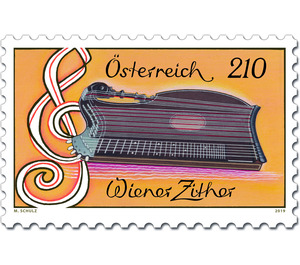Series Musical instruments - Viennese zither - Austria / II. Republic of Austria 2019 - 210 Euro Cent
Theme: Art & Culture
| Country | Austria / II. Republic of Austria |
| Issue Date | 2019 |
| Face Value | 210.00 |
| Color | brown yellow |
| Printing Type | combined offset and Typography |
| Stamp Type | Commemorative |
| Item Type | Stamp |
| SID | 965885 |
| Dimensions | 50.00 x 32.00 |
| In 79 Wishlists | |
This time, the stamp from the “Musical instruments” series presents an instrument which is inextricably linked to the musical culture of Vienna: the Viennese zither. It captivates the audience with its soft, tranquil sound. The term zither can be traced back to the Greek word kithara, from which the word guitar is also derived. Put simply, the zither comprises a shallow wooden case with strings stretched across it. The fingerboard is fretted and is used to play the melody. For this, the strings are plucked using a zither ring on the right thumb whilst the fingers of the other hand press the strings down onto the frets. The remaining supporting strings are played with the fingers of the playing (right) hand. The Viennese zither During the 19th century the zither made its way from rural areas into towns and cities, where it was at first primarily played in taverns. One of the first virtuoso performers on the zither was Johann Petzmayer, who was employed at the court of the Bavarian duke Max (Duke Maximilian Joseph), father of the later empress Elisabeth, and made the zither an instrument accepted in court circles – Sisi also learned to play. In 1856 the composer and musician Carl Ignaz Umlauf staged the first zither concert in the Wiener Musikverein, thereby definitively establishing the instrument’s place in classical music. It was also he who was responsible for developing the special Viennese tuning technique for the zither resulting from its characteristic stringing and playing techniques. The Viennese zither soon became known among both the bourgeoisie and the working classes as the “piano of the common man”. Even today it plays an important social and identity-building role in both folk music and in zither societies, which is why UNESCO added the “Viennese Tuning and Playing Technique for the Zither” to the catalogue of intangible cultural heritage in Austria in 2017. Nowadays the Viennese zither is well established in both classical music and in folk music and Wienerlied (Viennese song) as well as in jazz, pop and rock. Johann Strauss also featured the zither in a solo in his “Tales from the Viennese Wood”. The zither music performed by Anton Karas in the 1949 Oscar-winning film “The Third Man”, set in post-war Vienna, is known throughout the world.


